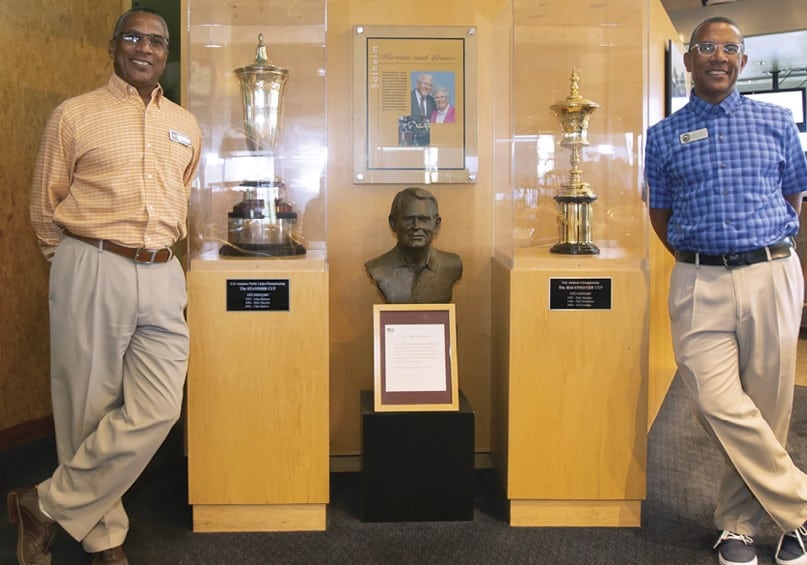Dr. Eric Brey, PhD, joins GGA Partners as a Director to bolster consumer research capabilities
TORONTO, Ontario – GGA Partners has expanded its portfolio of services for private clubs, public golf courses, residential communities, resorts, municipalities and hospitality clients with the addition of an experienced research mind and acting hospitality educator.
Dr. Eric Brey, PhD, a researcher and professor at the University of Wisconsin-Stout, School of Hospitality Leadership, has joined GGA Partners as its newest director to expand the firm’s research efforts.
Dr. Brey’s research expertise will strengthen GGA’s capabilities in customer feedback and market research, both of which are core services for GGA. One of the many expanded offerings the addition of Dr. Brey supports is 3-Factor Theory Analysis designed to provide a deeper and more meaningful understanding of the touchpoints that have the greatest potential to impact customer and member satisfaction.

Recently, Medinah Country Club engaged Dr. Brey to conduct 3-Factor Theory Analysis using the raw survey data collected by GGA. “Identifying the touchpoints important to our members provided tremendous insight across our entire operation” stated Medinah Country Club General Manager Robert Sereci. “Clubs will benefit greatly by using this methodology to pinpoint opportunities on which to focus enhancement efforts to achieve the highest level of enjoyment for their members.”
In addition to enhanced customer satisfaction analysis, Dr. Brey’s vast experience in consumer research will provide expanded opportunities for survey interpretation, managed customer feedback, third party performance monitoring and analysis of existing client data to support GGA’s strategic planning and business intelligence services.
“The synergies created by combining GGA’s expertise in research and strategic planning with the knowledge and experience I bring to consumer research are exponential,” commented Dr. Brey. “Together we will be able to assist golf, club, resort and municipal operators with more detailed and comprehensive data analysis that will enhance their ability to make strategic decisions and improve their operational efficiency and customer experience.”
“Research is a cornerstone of our firm and consumer satisfaction is just one component of GGA’s capabilities in this space. Dr. Brey will play a key role in elevating GGA’s industry leading research, and will apply research best practices and new methods to develop even stronger insights for our clients,” commented GGA Partner Michel Gregory. “As a firm we are working to develop an all-encompassing approach to measuring real time, periodic, and long-term consumer feedback that will benefit a wide range of clients in the private club, resort and hospitality industries as well as municipalities who own golf and leisure assets”.
About GGA Partners
GGA Partners™ is an international consulting firm and trusted advisor to many of the world’s most successful golf courses, private clubs, resorts, and residential communities. We are dedicated to helping owners, asset managers, club and community leaders, investors and real estate developers tackle challenges, achieve objectives, and maximize asset performance.
Established in 1992 as the KPMG Golf Industry Practice, our global team of experienced professionals leverage in-depth business intelligence and proprietary global data to deliver impactful strategic solutions and lasting success. For more information, please visit ggapartners.com.
About Dr. Eric Brey, PhD
Dr. Brey earned his B.S. and M.S. from the University of Wisconsin-Stout School of Hospitality Leadership. In 2006, he earned his PhD from Purdue University School of Hospitality and Tourism Management. Dr. Brey spent six years at the University of Memphis, Fogelman College of Business and Economics, Kemmons Wilson School of Hospitality Management before joining the University of Wisconsin-Stout, School of Hospitality Leadership in 2012. In his current role, he serves as professor and chair of the school, teaching marketing, strategy and customer analytics courses, and conducting research on consumer-centric strategy.
Dr. Brey has published numerous peer and refereed journal papers, written industry white papers and book chapters, received many recognitions and honors and has conducted applied research for the United States Golf Association. Recently, Dr. Brey completed a research study for the USGA identifying more than 1,000 touchpoints golfers can have throughout their experience that impact satisfaction and dissatisfaction. The results of the research will provide insights to help operators gain a firm understanding of what customers need and how to meet and exceed those expectations.
Media Contacts:
Michael Gregory, Partner
GGA Partners
416-524-0083
michael.gregory@ggapartners.com





